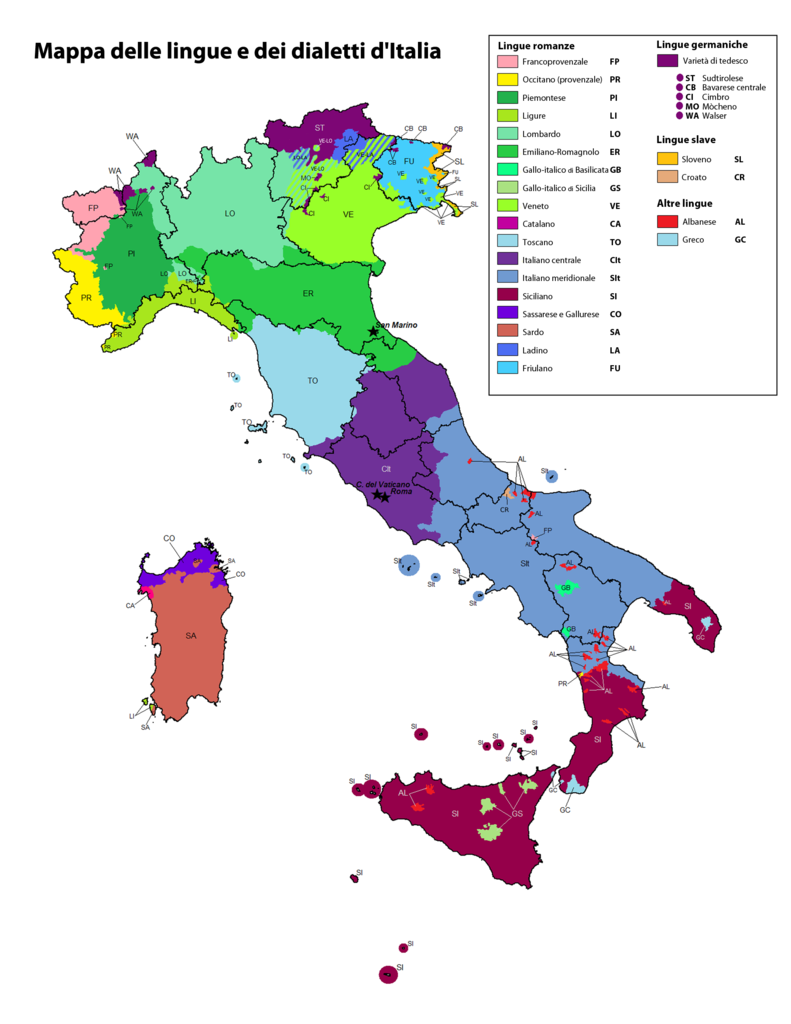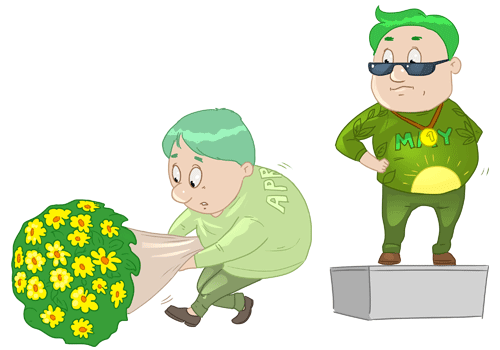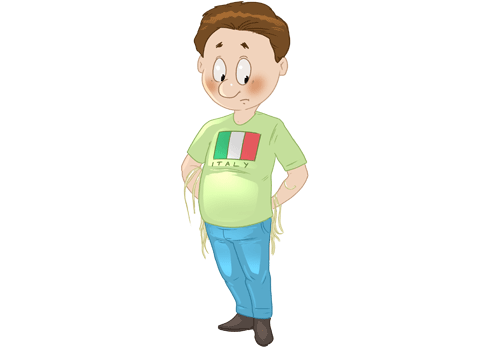Italian
Lingua italiana
Lingua italiana
about 65 million
Italy, Switzerland, San Marino, Vatican, EU
Croatia and Slovenia
Brazil (25 mln.), Argentina (24 mln.), USA (18 mln.), Canada (1.5 mln.), Uruguay (1.5 mln.), Australia (0.85 mln.) etc.


Italian is the official language in Italy, an official language of the EU, and a minority language in two other EU countries. It is one of the largest languages of the Union, next to German, English and French. It is not an international language like English, French or Spanish but it is widely used in the Mediterranean basin and learned as one of the most popular foreign languages in the world. Knowledge of Italian is indispensable for art historians and musicians, especially when opera is concerned. It is also very important for international gastronomy all over the world. Italian has influenced almost all languages of the world, especially in these fields. Words and expressions like sfumato, fresco, villa (in art and architecture), concerto, ballerina, allegro, baritone (in music), motto, novel, notturno (in literature) or spaghetti, espresso, pizza, pasta, but also zero, lava, volcano and neutrino (in science) are just some of thousands that have entered all European languages. It says something about the almost absolute dominance of Italian culture in European history, from Roman times through Renaissance and up to the present. French borrowed about 3000 words from Italian. Dialects of French, Croatian or Slovenian near the Italian border are thoroughly influenced by Italian and the Maltese language is full of Italian words. It should not be forgotten that Italian is the actual working language of the Vatican and thus has an important place in the entire Catholic world.
Italian has lost the case inflection of Latin, except for personal pronouns: (io, me – I, me) and has two grammatical genders, with agreement between articles, adjectives and nouns. Gender is shown either by article or word ending: un ragazzo buono (a good boy), una ragazza buona (a good girl). Only personal pronouns show inflection. A typical feature of article inflection is the contraction of articles with prepositions: del, dello, dell‘, dei, degli, della, delle etc.
| Singular | Plural | |||
|---|---|---|---|---|
| Definite | Indefinite | Definite | Indefinite | |
| Male -o | il ragazzo boy |
un ragazzo | i ragazzi | dei ragazzi |
| Female -a | la ragazza girl |
una ragazza | le ragazze | delle ragazze |
| Male -o Initial vowel |
l’amico friend |
un amico | gli amici | degli amici |
| Female -a Initial vowel |
l’amica friend |
una amica un’ idea |
le amiche delle idee |
delle amiche |
| Initial s+consonant | lo scopo target |
uno scopo | gli scopi | gli scopi |
Word formation is such that Italian avoids compound words. The usual word order is SVO and adjectives follow nouns: una casa grande (a big house).
Verbs inflect for person and number, and agree with the subject. Italian has many irregular verbs. The regular verbs fall into three (or four) groups depending on the infinitive ending (-are, -ere, ire, -isco: parlare, credere, partire, finire, finisco). Here is an overview of the regular verb conjugation for a verb of the first group:
| Singular | Plural | |||||
|---|---|---|---|---|---|---|
| 1st person | 2nd person | 3rd person | 1st person | 2nd person | 3rd person | |
| Indicative | ||||||
| Present simple | io amo | tu ami | egli ama | noi amiamo | voi amate | essi amano |
| Present perfect | io ho amato | tu hai amato | egli ha amato | noi abbiamo amato | voi avete amato | essi hanno amato |
| Imperfect | io amavo | tu amavi | egli amava | noi amavamo | voi amavate | essi amavano |
| Past perfect | o avevo amato | tu avevi amato | egli aveva amato | noi avevamo amato | voi avevate amato | essi avevano amato |
| Past absolute | io amai | tu amasti | egli amò | noi amammo | voi amaste | essi amarono |
| Remote past perfect | io ebbi amato | tu avesti amato | egli ebbe amato | noi avemmo amato | voi aveste amato | essi ebbero amato |
| Future simple | io amerò | tu amerai | egli amerà | noi ameremo | voi amerete | essi ameranno |
| Future perfect | io avrò amato | tu avrai amato | egli avrà amato | noi avremo amato | voi avrete amato | essi avranno amato |
| Subjunctive | ||||||
| Present | che io ami | che tu ami | che egli ami | che noi amiamo | che voi amiate | che essi amino |
| Past | che io abbia amato | che tu abbia amato | che egli abbia amato | che noi abbiamo amato | che voi abbiate amato | che essi abbiano amato |
| Imperfect | che io amassi | che tu amassi | che egli amasse | che noi amassimo | che voi amaste | che essi amassero |
| Plusquamperfekt | che io avessi amato | che tu avessi amato | che egli avesse amato | che noi avessimo amato | che voi aveste amato | che essi avessero amato |
| Conditional | ||||||
| Present conditional | io amerei | tu ameresti | egli amerebbe | noi ameremmo | voi amereste | essi amerebbero |
| Past conditional | io avrei amato | tu avresti amato | egli avrebbe amato | noi avremmo amato | voi avreste amato | essi avrebbero amato |
| Imperative | ||||||
| Present | — | ama | ami | amiamo | amate | amino |
| Infinitive | ||||||
| Present | amare | |||||
| Past | avere amato | |||||
| Participle | ||||||
| Present | amante | |||||
| Past | amato | |||||
| Gerundive | ||||||
| Present | amando | |||||
| Past | avendo amato | |||||
The linguistic variety in Italy is in fact larger than in the rest of the Romance speaking countries put together. Standard Italian is in many respects closer to Spanish or Portuguese than to Piedmontese or Neapolitan. Piedmontese dialects are in some ways closer to Provencal and French than to Italian. Other major local languages – Venetian, Emilian, Romagnolo, Lombardian, Genovese-Ligurian, Neapolitan, Sicilian – are independent developments from Vulgar Latin, thus dialects of Latin, not of Tuscan Italian, which is the base of Standard Italian. It is thus more proper to speak of Languages of Italy than of Italian dialects, as each of these vernaculars have dialects and some of them posses a written form and often a rich literature.
Tuscan is still considered the "purest" of all Italian dialects as it is the most similar to the original or classical Latin. The most influential language variety at present is often called Lingua toscana in bocca Romana: Tuscan language in a Roman mouth. However, it was not until the 19th century that the language spoken by educated Tuscans spread to become the language of a new nation. The unification of Italy in 1861 had a profound impact not only on the political scene but also resulted in significant social, economical, and cultural transformations. With mandatory schooling, the literacy rate increased, and many people abandoned their native dialects in favour of the national language or developed a local accent or version of the standard language (Italiano popolare), colored by the local vernaculars.

Source: Wikimedia Commons











